It looks like you're using an Ad Blocker.
Please white-list or disable AboveTopSecret.com in your ad-blocking tool.
Thank you.
Some features of ATS will be disabled while you continue to use an ad-blocker.
share:
Back when I was a kid, when the Earth was young and dinosours roamed the land, I used to lay out at night, looking up at the stars, wanting to see
them more up close.
I had a lot of books then, showing these incredible images of objects in our sky, with mind boggling colors and shapes that intrigued me.
Then I became a teenager, living in Italy as a military brat and promptly forgot all about them.
Weeeellll.....not completely. Instead of being outside gazing up at the stars, I had people like Issaac Asimov, Arthur C. Clarke, Larry Niven and Ben Bova filling my imagination of them as I devoured the science fiction books they wrote.
Until I joined the US Navy and then promptly forgot about them. Hard to think about the stars when you're doing push ups over hot pavement, having your head shaved, and being yelled at 24/7. But that ended after a few months, and after going through all these tech schools for radar systems, I finally got to my first ship and put out to sea.
I thought I knew what it was to stand under the stars. I was wrong. On a crystal clear night back in March of 1986, over 100 miles away from any land in the Gulf of Mexico, I stood under the stars with no Moon in the sky.
It was glorious. Thousands and thousands of stars, different colors, and all mine to look at. The aft look out was standing there and he knew I was a noob, first time at sea. He told me I would get used to it.
I told him that I hoped to god I never got used to it. I decided right then and there I would find a way to put what I was seeing in pictures.
Well, that took a while. This thing called "life" got in the way. But one day I finally go to where I could start trying, and that was back in 1998. I got my hands on a old Canon AE-1 SLR camera with a 50mm lens, a telescope with a heavy equatorial mount, and started taking images of the night sky.
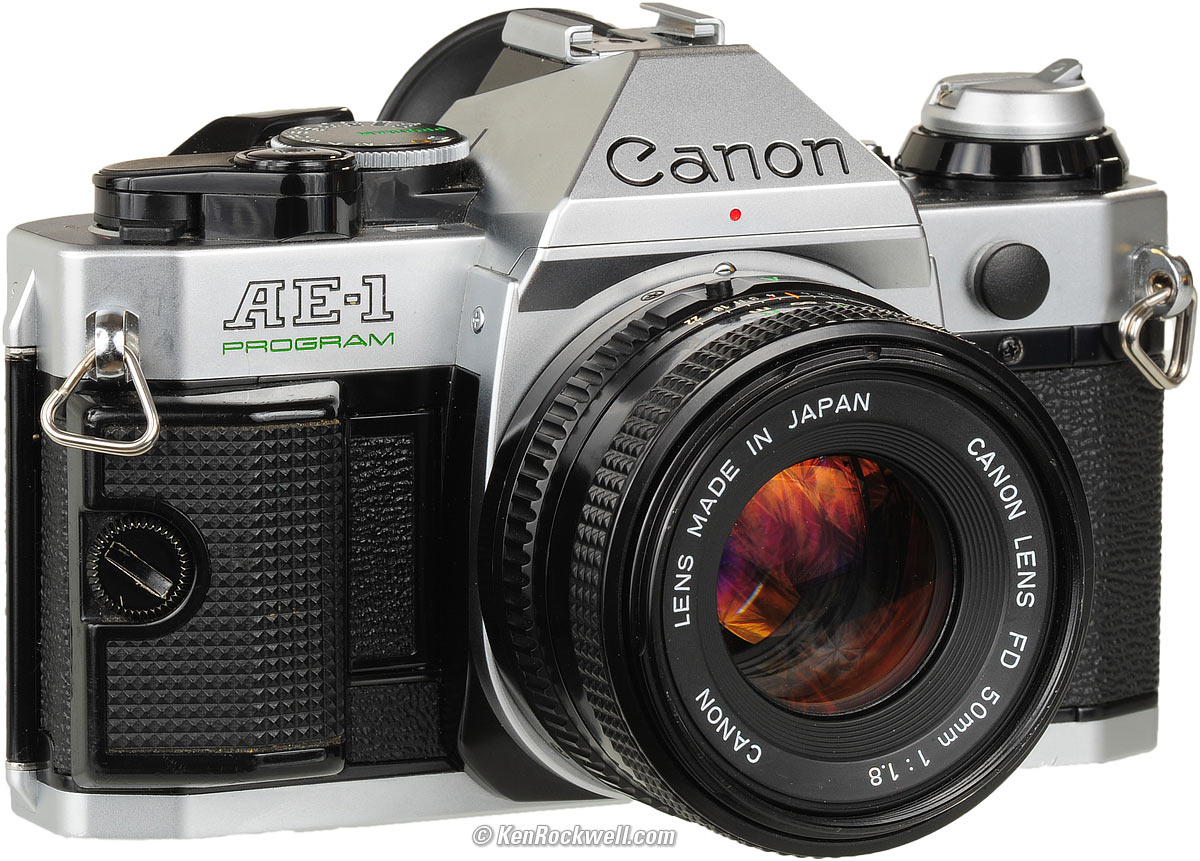
Now, right away I had a problem with this camera: it uses a battery to hold the shutter open. While that might not sound like a big deal, it is when you're taking astrophotography shots with a film camera. The frame of the film needs to be exposed for long periods of time because the light coming from the heavens is dim. Very dim, and holding the shutter open on this camera sucks the life out of the battery....which is not rechargable, and gets damn expensive to buy...when you can find it. Remember, this was before the days of consumer ready digital cameras using CCD chips and the internet was this thing they kept talking about, but all anyone had was America On Line, hehe.
Film was another issue:
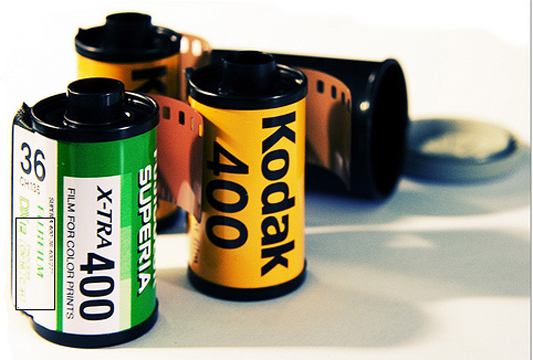
It was an issue because: it get's expensive to buy the film, and to pay for it to be developed. If you were lucky, you had your own developing room and knew how to do this.
Or, you were like me and had to take it somewhere, and hope that the people developing it understood you when you told them it was star shots.
Then of course there was the wait time. You took your pictures......then had to wait until you got those pictures developed, so it could take you days to weeks before you would know if any of your pictures came out.
Agonizing to say the least!
I spent more time looking at horrible images and failed shots then I did seeing good ones. I think most would have given up, but not me. I was encouraged by the very few successes that I had:
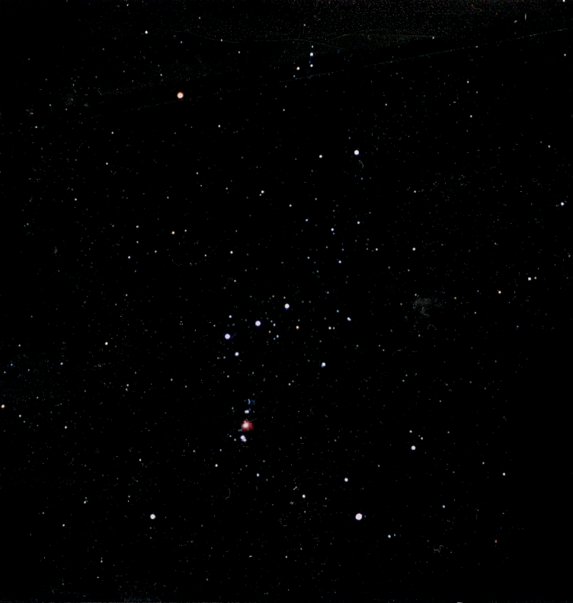
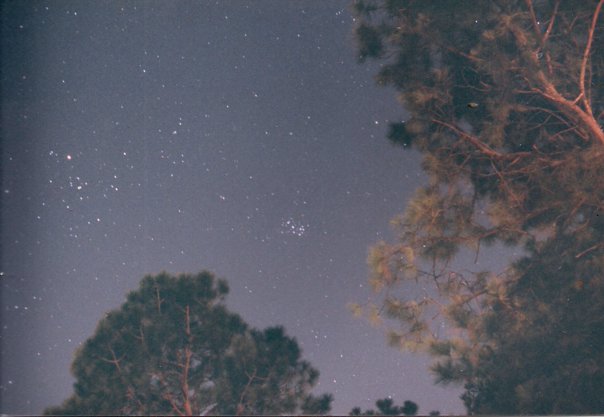
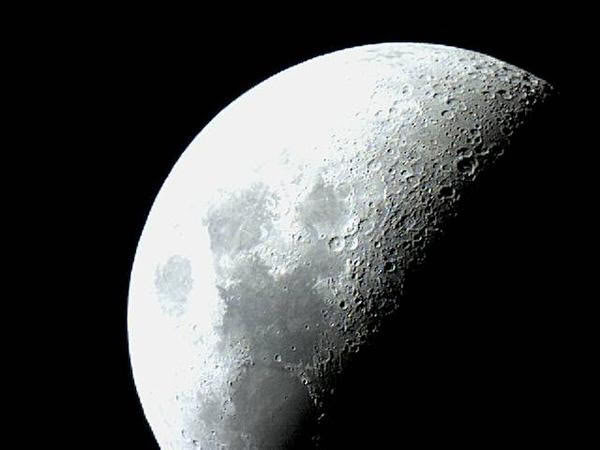
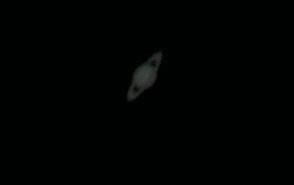
I even got some shots of a partial solar eclipse we had here back in 1998:
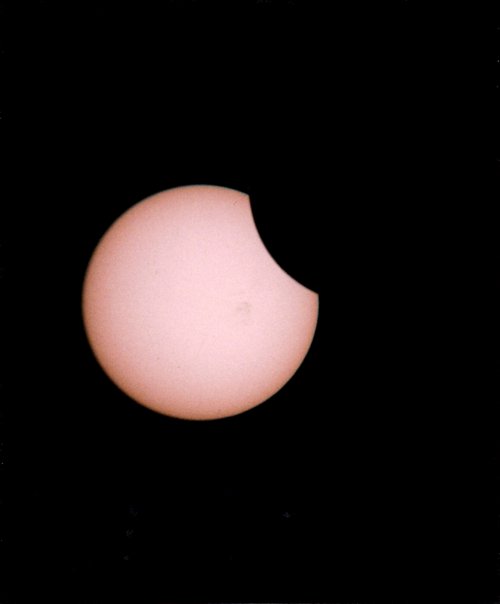
Can't wait for the total solar eclipse we're going to see this August.
After a while, life got in the way again, and it would be years before I ventured out again, only this time armed with this new fangled technology called the CCD Chip (Charged Coupled Device) that digital cameras use.
I got my hands on a Canon T3 Rebel DSLR camera, with the stock 11mm-55mm lense that comes with it:
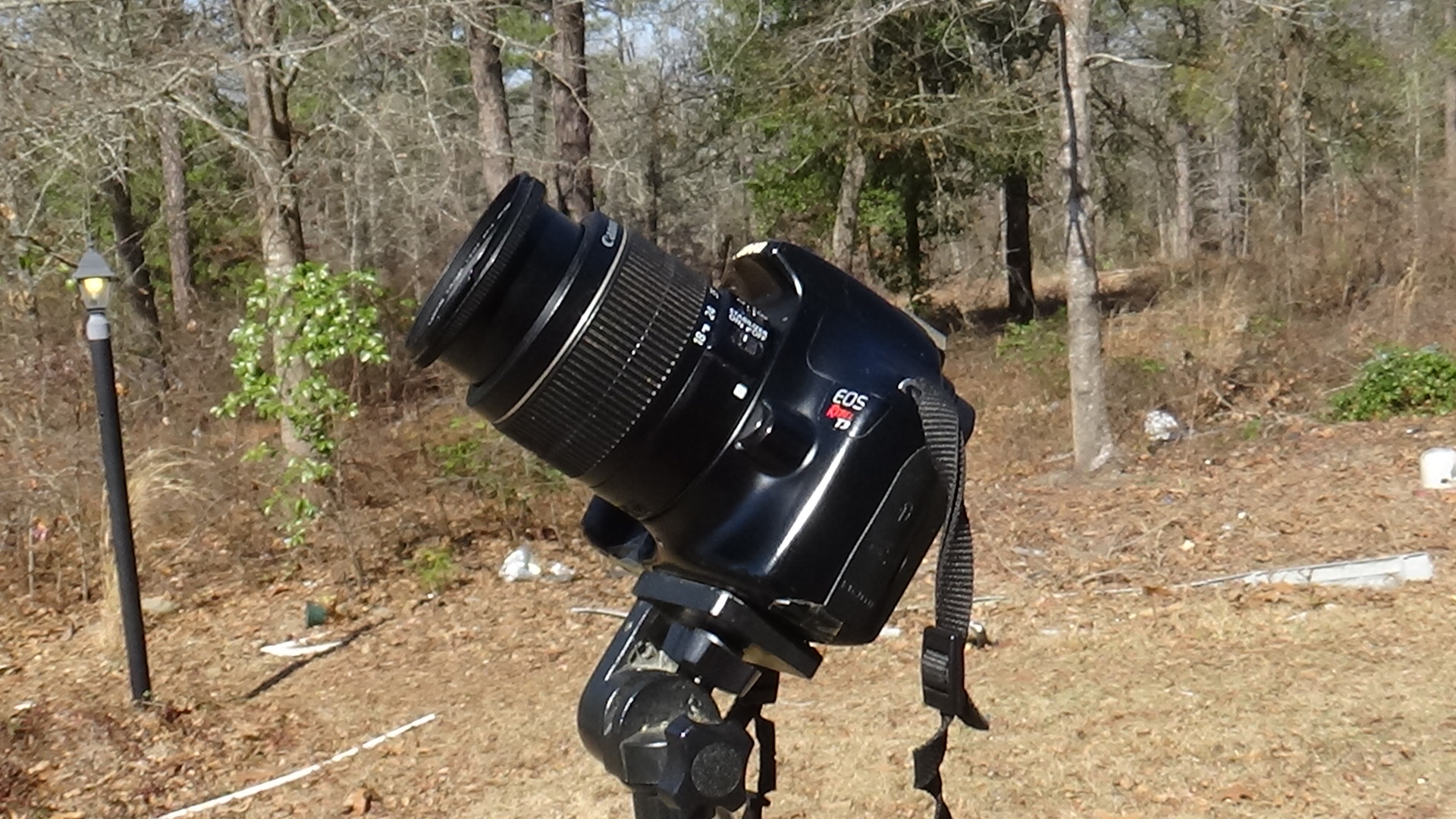
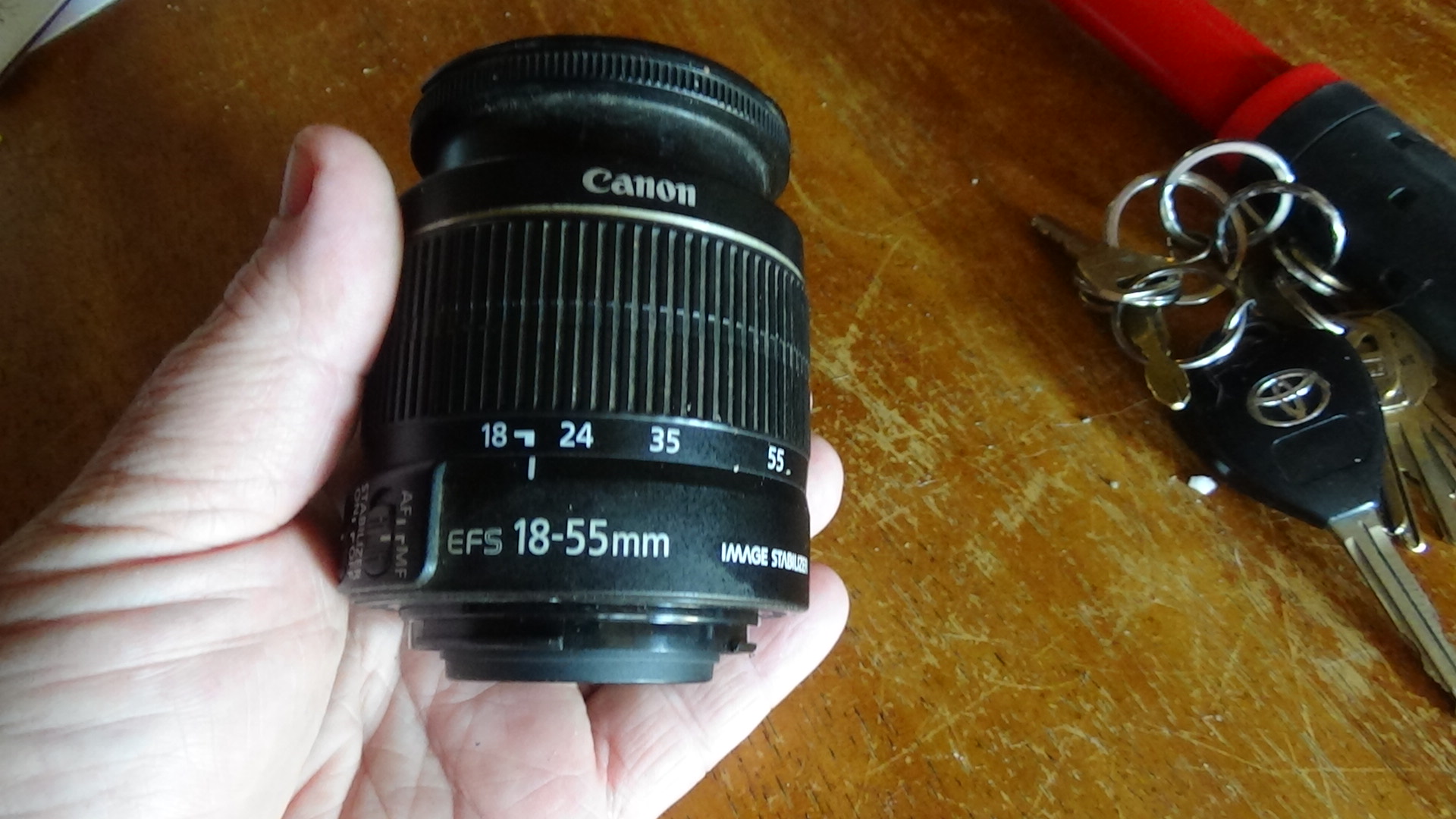
As hard as it was dealing with a SLR camera and film, I just knew this was going to be a piece of cake, and everything would get easy!
Wrong.
Well....it is nice that I do not have to buy film anymore, and my battery lasts for many hours, and I can see the image I took right away. Those things are all wonderful.
But capturing the images turned out to be a challenge right away. First shots I took looked horrible, and I couldn't understand why the stars didn't look like sharp points. I knew I was not over exposing the shots, allowing the stars to streak from the Earth rotating, but my stars looked like big baloons.
It was the lens. Specifically the EF lens that has a motor in it for the auto focus feature.
In the old days, when we actually had to use our hands and eyes to set up the lens, turning the focus ring all the way to infinity was where it stopped. In the dark, I could turn it all the way to the stop and knew I was focused on infinity, perfect for star shots.
The new EF lenses have their stop located pass where infinate focus is located. The camera will not auto focus on the stars either: their light is too dim. The focus will hunt around.
So, there are a couple of things you can do: use the "Live View" on the back of the camera screen, and try to zoom in on a very bright star like Sirius or on planet Venus if it's out, and slowly turn the focus ring until you get your point of light.
Even then, you have to be very careful because the slightest bump or tap will put it out of focus again.
While that's a pain, it is still amazing to be able to take my images and see what I'm getting right away:
The Milky Way:
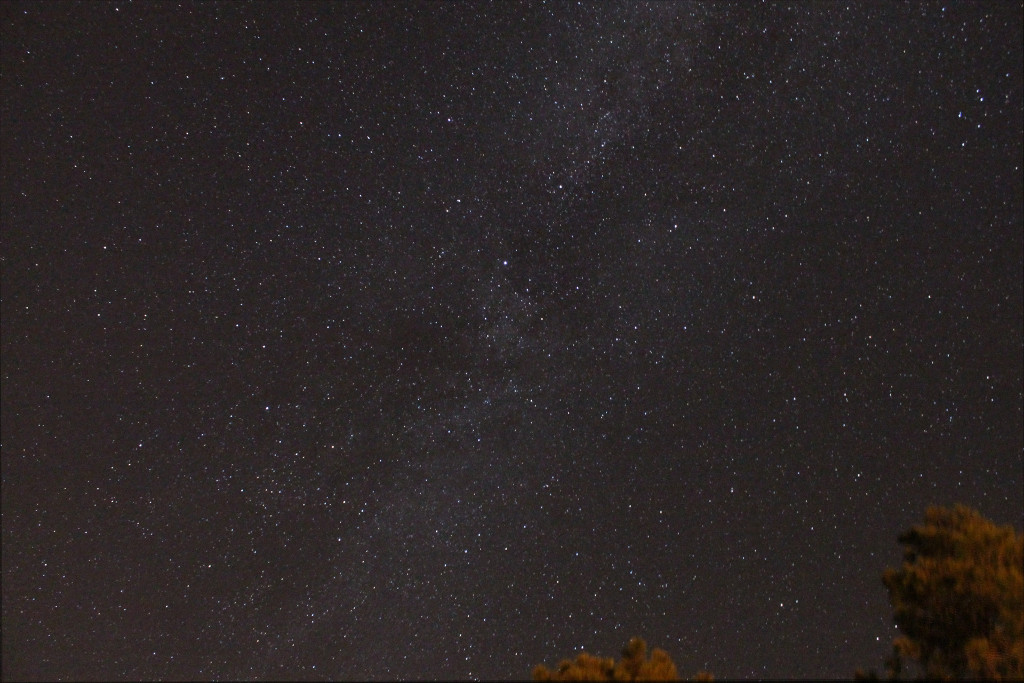
For the last couple of years I've been busy doing a lot of things, and had not gotten back to this. Too busy with life.......moderating here on ATS, and other stuff. But I decided to get back into this.
So for the last few nights, here are some of the things I've been doing:
The constellation Perseus (looking towards the North West). That's the Pleiades towards the upper left hand corner. This is a stack of 5 frames, at ISO 1600, f4.5, 15 seconds exposure at 18mm.
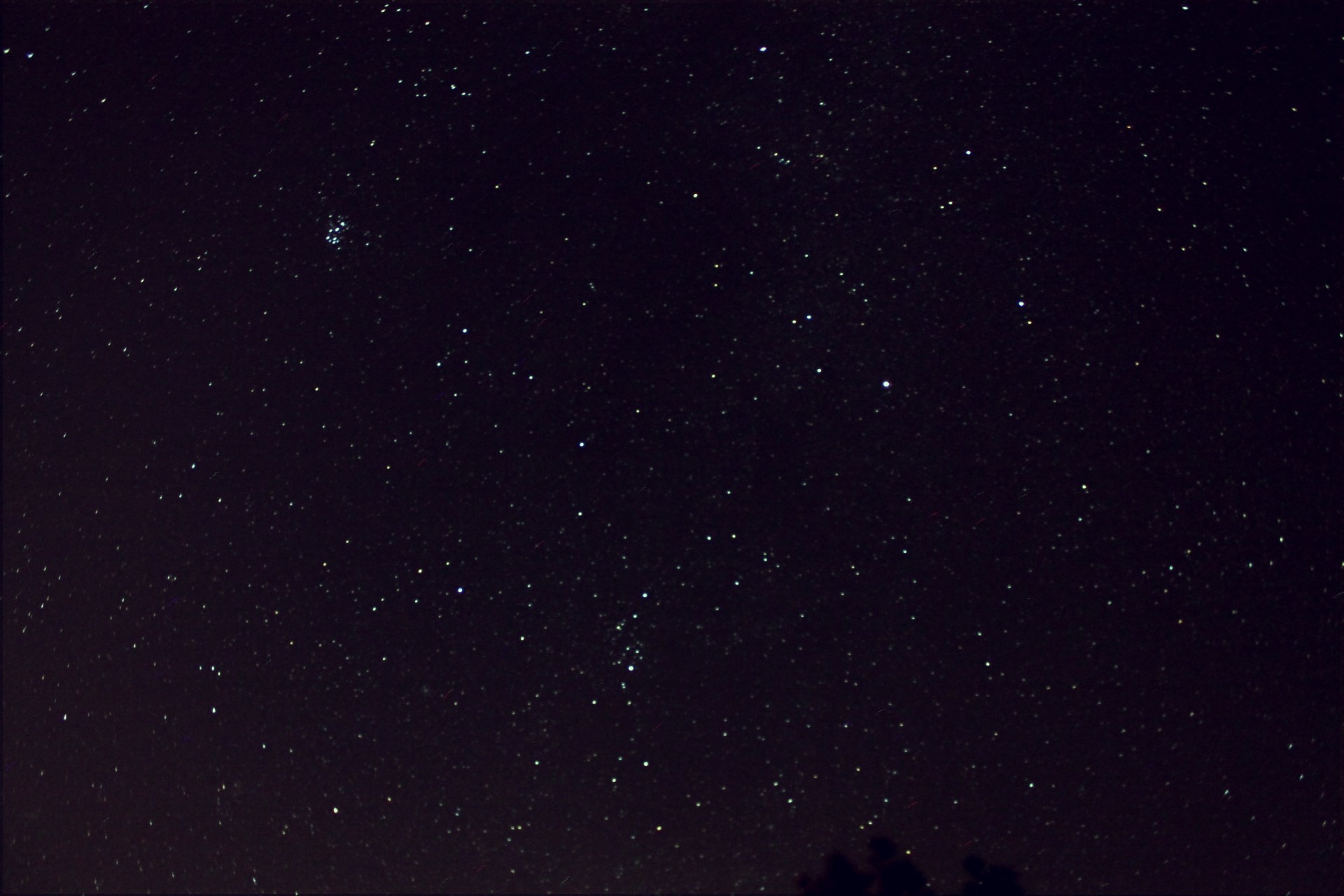
The Pleiades. Stack of 6 frames at ISO 1600, f4.0, 15 second exposures at 55mm:

Now look at the next two pictures. This is the constellation Orion. This first image is a single frame of ISO 3200, f3.5, 21mm at 15 seconds of exposure:
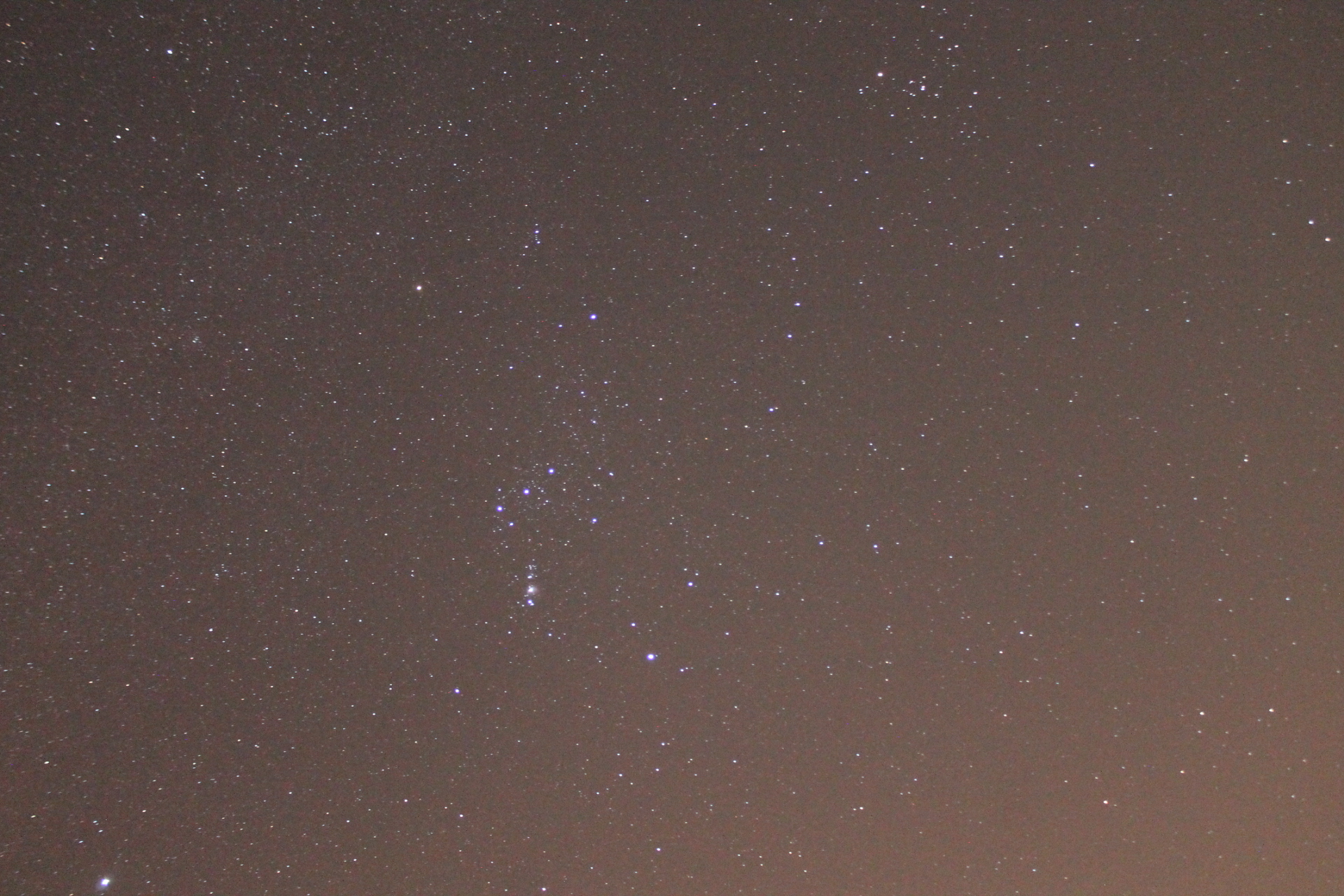
Here it is again using a "dark frame" to help remove thermal noise, and cleaned up with my imaging software:

Love how blue looking some of the stars are.
I had a lot of books then, showing these incredible images of objects in our sky, with mind boggling colors and shapes that intrigued me.
Then I became a teenager, living in Italy as a military brat and promptly forgot all about them.
Weeeellll.....not completely. Instead of being outside gazing up at the stars, I had people like Issaac Asimov, Arthur C. Clarke, Larry Niven and Ben Bova filling my imagination of them as I devoured the science fiction books they wrote.
Until I joined the US Navy and then promptly forgot about them. Hard to think about the stars when you're doing push ups over hot pavement, having your head shaved, and being yelled at 24/7. But that ended after a few months, and after going through all these tech schools for radar systems, I finally got to my first ship and put out to sea.
I thought I knew what it was to stand under the stars. I was wrong. On a crystal clear night back in March of 1986, over 100 miles away from any land in the Gulf of Mexico, I stood under the stars with no Moon in the sky.
It was glorious. Thousands and thousands of stars, different colors, and all mine to look at. The aft look out was standing there and he knew I was a noob, first time at sea. He told me I would get used to it.
I told him that I hoped to god I never got used to it. I decided right then and there I would find a way to put what I was seeing in pictures.
Well, that took a while. This thing called "life" got in the way. But one day I finally go to where I could start trying, and that was back in 1998. I got my hands on a old Canon AE-1 SLR camera with a 50mm lens, a telescope with a heavy equatorial mount, and started taking images of the night sky.

Now, right away I had a problem with this camera: it uses a battery to hold the shutter open. While that might not sound like a big deal, it is when you're taking astrophotography shots with a film camera. The frame of the film needs to be exposed for long periods of time because the light coming from the heavens is dim. Very dim, and holding the shutter open on this camera sucks the life out of the battery....which is not rechargable, and gets damn expensive to buy...when you can find it. Remember, this was before the days of consumer ready digital cameras using CCD chips and the internet was this thing they kept talking about, but all anyone had was America On Line, hehe.
Film was another issue:

It was an issue because: it get's expensive to buy the film, and to pay for it to be developed. If you were lucky, you had your own developing room and knew how to do this.
Or, you were like me and had to take it somewhere, and hope that the people developing it understood you when you told them it was star shots.
Then of course there was the wait time. You took your pictures......then had to wait until you got those pictures developed, so it could take you days to weeks before you would know if any of your pictures came out.
Agonizing to say the least!
I spent more time looking at horrible images and failed shots then I did seeing good ones. I think most would have given up, but not me. I was encouraged by the very few successes that I had:




I even got some shots of a partial solar eclipse we had here back in 1998:

Can't wait for the total solar eclipse we're going to see this August.
After a while, life got in the way again, and it would be years before I ventured out again, only this time armed with this new fangled technology called the CCD Chip (Charged Coupled Device) that digital cameras use.
I got my hands on a Canon T3 Rebel DSLR camera, with the stock 11mm-55mm lense that comes with it:


As hard as it was dealing with a SLR camera and film, I just knew this was going to be a piece of cake, and everything would get easy!
Wrong.
Well....it is nice that I do not have to buy film anymore, and my battery lasts for many hours, and I can see the image I took right away. Those things are all wonderful.
But capturing the images turned out to be a challenge right away. First shots I took looked horrible, and I couldn't understand why the stars didn't look like sharp points. I knew I was not over exposing the shots, allowing the stars to streak from the Earth rotating, but my stars looked like big baloons.
It was the lens. Specifically the EF lens that has a motor in it for the auto focus feature.
In the old days, when we actually had to use our hands and eyes to set up the lens, turning the focus ring all the way to infinity was where it stopped. In the dark, I could turn it all the way to the stop and knew I was focused on infinity, perfect for star shots.
The new EF lenses have their stop located pass where infinate focus is located. The camera will not auto focus on the stars either: their light is too dim. The focus will hunt around.
So, there are a couple of things you can do: use the "Live View" on the back of the camera screen, and try to zoom in on a very bright star like Sirius or on planet Venus if it's out, and slowly turn the focus ring until you get your point of light.
Even then, you have to be very careful because the slightest bump or tap will put it out of focus again.
While that's a pain, it is still amazing to be able to take my images and see what I'm getting right away:
The Milky Way:

For the last couple of years I've been busy doing a lot of things, and had not gotten back to this. Too busy with life.......moderating here on ATS, and other stuff. But I decided to get back into this.
So for the last few nights, here are some of the things I've been doing:
The constellation Perseus (looking towards the North West). That's the Pleiades towards the upper left hand corner. This is a stack of 5 frames, at ISO 1600, f4.5, 15 seconds exposure at 18mm.

The Pleiades. Stack of 6 frames at ISO 1600, f4.0, 15 second exposures at 55mm:

Now look at the next two pictures. This is the constellation Orion. This first image is a single frame of ISO 3200, f3.5, 21mm at 15 seconds of exposure:

Here it is again using a "dark frame" to help remove thermal noise, and cleaned up with my imaging software:

Love how blue looking some of the stars are.
I've got some new equipment on the way so I can start getting into the meat of it. I found this 500mm telephoto lense on Amazon for only 75 dollars,
it's old school, but comes with a special adaptor that fits the new Canon DSLR camera like mine:

Also picked up a SLY2X converter....it'll make my 500mm telephoto into a 1,000mm one:
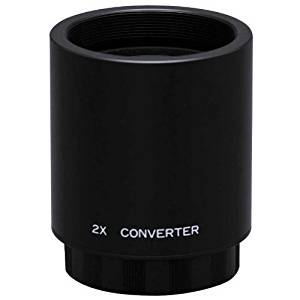
Some time later this week, I'll be ordering these two things. First a heavy duty equatorial mount with a polar alignment scope and a motor to compensate for the Earth's rotation:
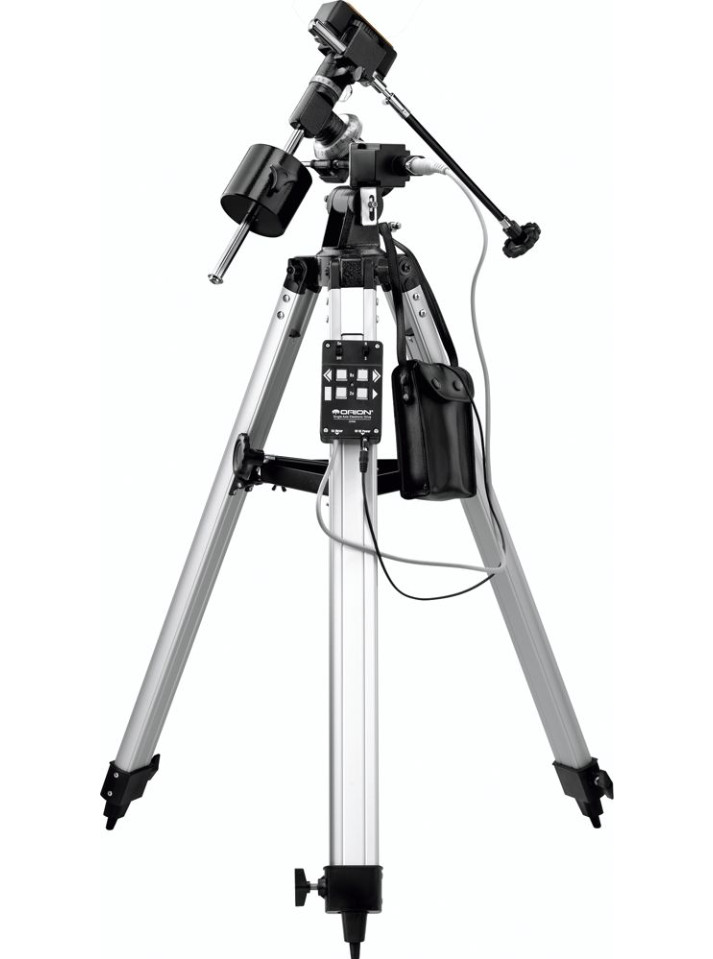
That will allow me to take much longer exposures, which is really needed when you zoom in on objects.
I'm also picking up this 6.5mm wide angle lens:
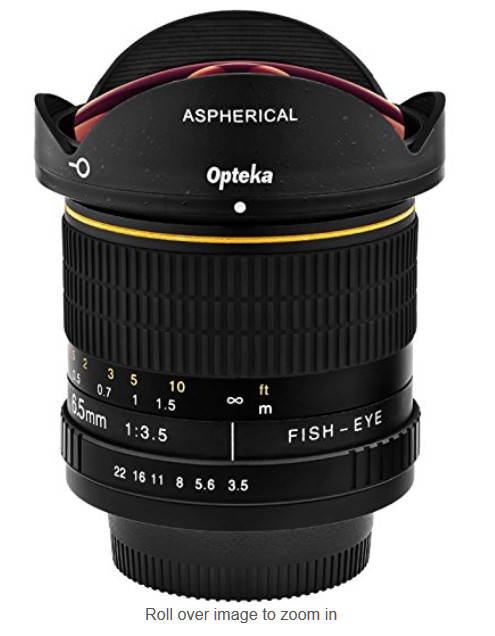
You can also do shots with cheaper cameras. I've used my Sony Handycam to take some very interesting images of the Moon:
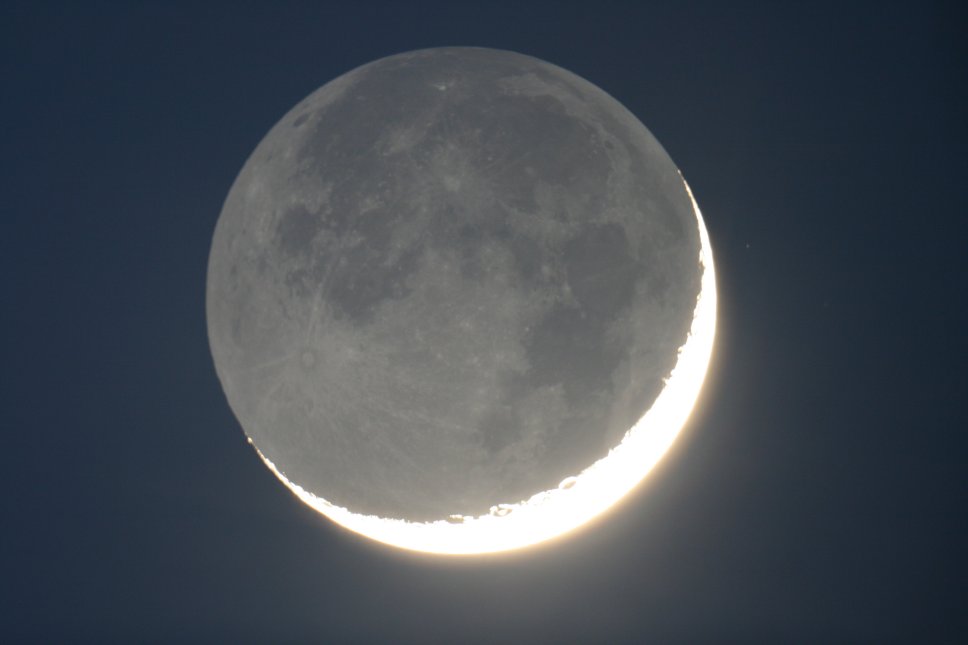
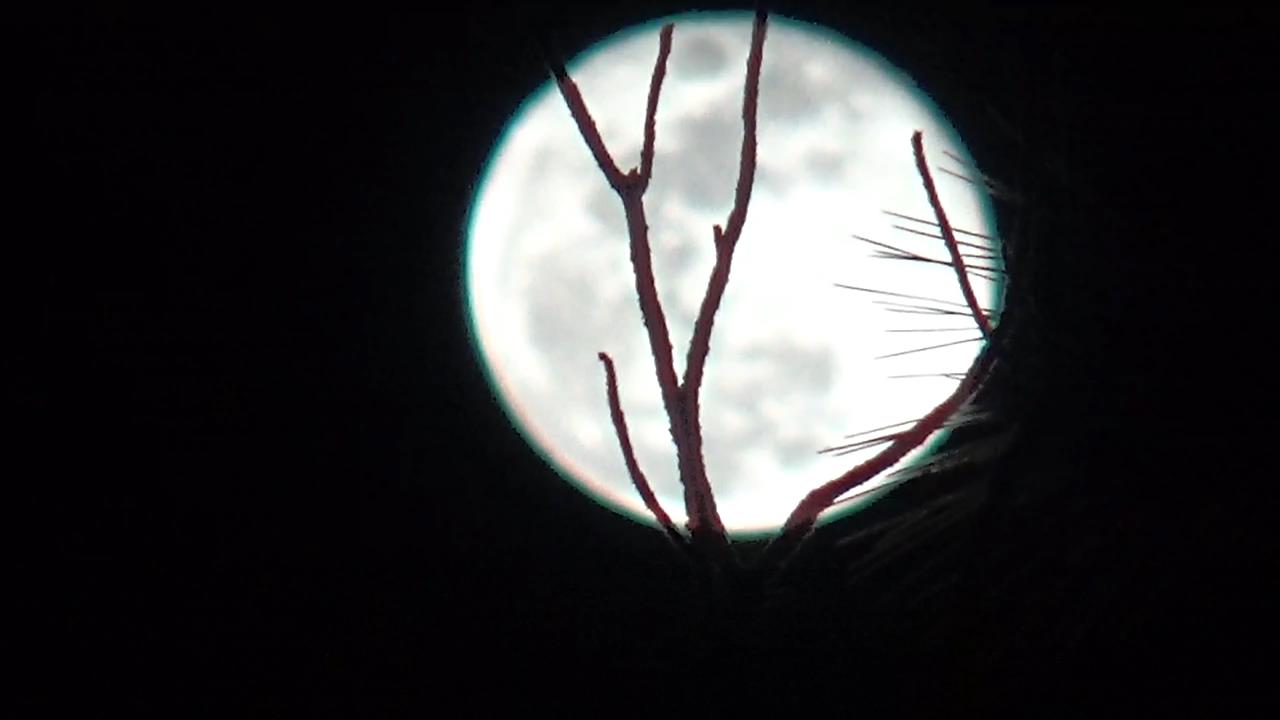
Most of my new images, I'll more than likely post over in our Astrophotography thread we have here on ATS. This thread was just something I felt like making, and I'd like to hear from y'all, your thoughts? You have any stories about how you got started? Pics to share?

Also picked up a SLY2X converter....it'll make my 500mm telephoto into a 1,000mm one:

Some time later this week, I'll be ordering these two things. First a heavy duty equatorial mount with a polar alignment scope and a motor to compensate for the Earth's rotation:

That will allow me to take much longer exposures, which is really needed when you zoom in on objects.
I'm also picking up this 6.5mm wide angle lens:

You can also do shots with cheaper cameras. I've used my Sony Handycam to take some very interesting images of the Moon:


Most of my new images, I'll more than likely post over in our Astrophotography thread we have here on ATS. This thread was just something I felt like making, and I'd like to hear from y'all, your thoughts? You have any stories about how you got started? Pics to share?
a reply to: eriktheawful
Not that it has much to do with your story but I also am a former navy guy, retired, and while I enjoyed looking at a clear moonless sky out at sea and putting the Big Eyes to good use at night, I did not fully appreciate the opportunity. Since then, however I have started the hobby of astronomy and astrophotography. It is complicated but really rewarding. Not really possible on a moving ship unfortunately. Basically, from what I am reading, the best way to capture a really accurate detailed photo is through the use of video and stacking software. I am just learning how to do it....I have the camera, the software, the necessary laptop, and an expensive telescope. It takes a lot of planning for each night of picture taking. I begin setting up around 3pm, planning what I am going to shoot and how it will be accomplished. This spring I am switching from a CCD camera to my Nikon with a specific mount. If I can succeed in getting a clear shot of Mars or Saturn I will turn my attention to deep space and go for M31 or a nebula.
Astronomy has been a great hobby. I am an old guy, 61, but it has connected me with much younger men and women that I would not ordinary have anything in common with. The one phrase I remember from one of my daughters high school classmate who I met on a camping trip. She invited me to the local astronomy group sky parties and her comment said it all: "there is SO much to learn!" when we were discussing all the cool stuff out in space the average guy never even considers. I absolutely love this hobby. I subscribed to Astronomy Magazine (very cheap) and it has brilliant articles every month, including a day to day description of what will be in the sky the succeeding month. And how to view them.
Not that it has much to do with your story but I also am a former navy guy, retired, and while I enjoyed looking at a clear moonless sky out at sea and putting the Big Eyes to good use at night, I did not fully appreciate the opportunity. Since then, however I have started the hobby of astronomy and astrophotography. It is complicated but really rewarding. Not really possible on a moving ship unfortunately. Basically, from what I am reading, the best way to capture a really accurate detailed photo is through the use of video and stacking software. I am just learning how to do it....I have the camera, the software, the necessary laptop, and an expensive telescope. It takes a lot of planning for each night of picture taking. I begin setting up around 3pm, planning what I am going to shoot and how it will be accomplished. This spring I am switching from a CCD camera to my Nikon with a specific mount. If I can succeed in getting a clear shot of Mars or Saturn I will turn my attention to deep space and go for M31 or a nebula.
Astronomy has been a great hobby. I am an old guy, 61, but it has connected me with much younger men and women that I would not ordinary have anything in common with. The one phrase I remember from one of my daughters high school classmate who I met on a camping trip. She invited me to the local astronomy group sky parties and her comment said it all: "there is SO much to learn!" when we were discussing all the cool stuff out in space the average guy never even considers. I absolutely love this hobby. I subscribed to Astronomy Magazine (very cheap) and it has brilliant articles every month, including a day to day description of what will be in the sky the succeeding month. And how to view them.
a reply to: eriktheawful
Thanks for the stroll down your memory lane and the pics. I have always been interested in astrophotography, but have never really taken it very seriously because, like you, life often gets in the way.
I'll be taking a 7-day cruise this summer, and I plan on getting up on the top deck in the early hours of the morning to try and get some pictures, but on a moving ship on a moving planet, I'm not too certain that I'll get anything great using just a standard tri-pod.
Regardless, I really just want to be like you and stand out under a perfectly viewable, no-light-pollution sky and just take in the experience of seeing what the sky should look like, pondering and gaining a better understanding as to why ancient civilizations held the stars in such high regard.
Thanks for a little motivation to get out and try a little harder--or, at the very least, start trying again.
Thanks for the stroll down your memory lane and the pics. I have always been interested in astrophotography, but have never really taken it very seriously because, like you, life often gets in the way.
I'll be taking a 7-day cruise this summer, and I plan on getting up on the top deck in the early hours of the morning to try and get some pictures, but on a moving ship on a moving planet, I'm not too certain that I'll get anything great using just a standard tri-pod.
Regardless, I really just want to be like you and stand out under a perfectly viewable, no-light-pollution sky and just take in the experience of seeing what the sky should look like, pondering and gaining a better understanding as to why ancient civilizations held the stars in such high regard.
Thanks for a little motivation to get out and try a little harder--or, at the very least, start trying again.
a reply to: SlapMonkey
Well if it's a cruise ship, hopefully it will be riding steady.....unlike the 53 foot wide, 513 feet long destroyers I was on, hehehe. We'd leave foot prints on the bulkheads.
The only thing I'm thinking though is: ship lights.
In the US Navy, we cruise around with no lights on (just navigational lights during peace time steaming).
A cruise ship on the other hand is lit up like a Christmas tree! But! That could make for some really cool low light shots I'm thinking.
In any case: nothing ventured, nothing gained. If you get any shots you like, please share them with us here! I like to "Ooooo" and "Ahhhh" over other people's stuff.
Well if it's a cruise ship, hopefully it will be riding steady.....unlike the 53 foot wide, 513 feet long destroyers I was on, hehehe. We'd leave foot prints on the bulkheads.
The only thing I'm thinking though is: ship lights.
In the US Navy, we cruise around with no lights on (just navigational lights during peace time steaming).
A cruise ship on the other hand is lit up like a Christmas tree! But! That could make for some really cool low light shots I'm thinking.
In any case: nothing ventured, nothing gained. If you get any shots you like, please share them with us here! I like to "Ooooo" and "Ahhhh" over other people's stuff.
(post by NewGeneralCatalog removed for a serious terms and conditions violation)
Okay, now this image here is a stack of 24 images that I took back in November of 2013. It's the Milky Way.
They were all at ISO 6400, with the lens set to 18mm, f5.6. About half were at 20 seconds exposure and the other half at 30 seconds exposure.
The bottom right hand corner is lit up mostly due to a security lamp on a power pole about 400 yards away, heh.
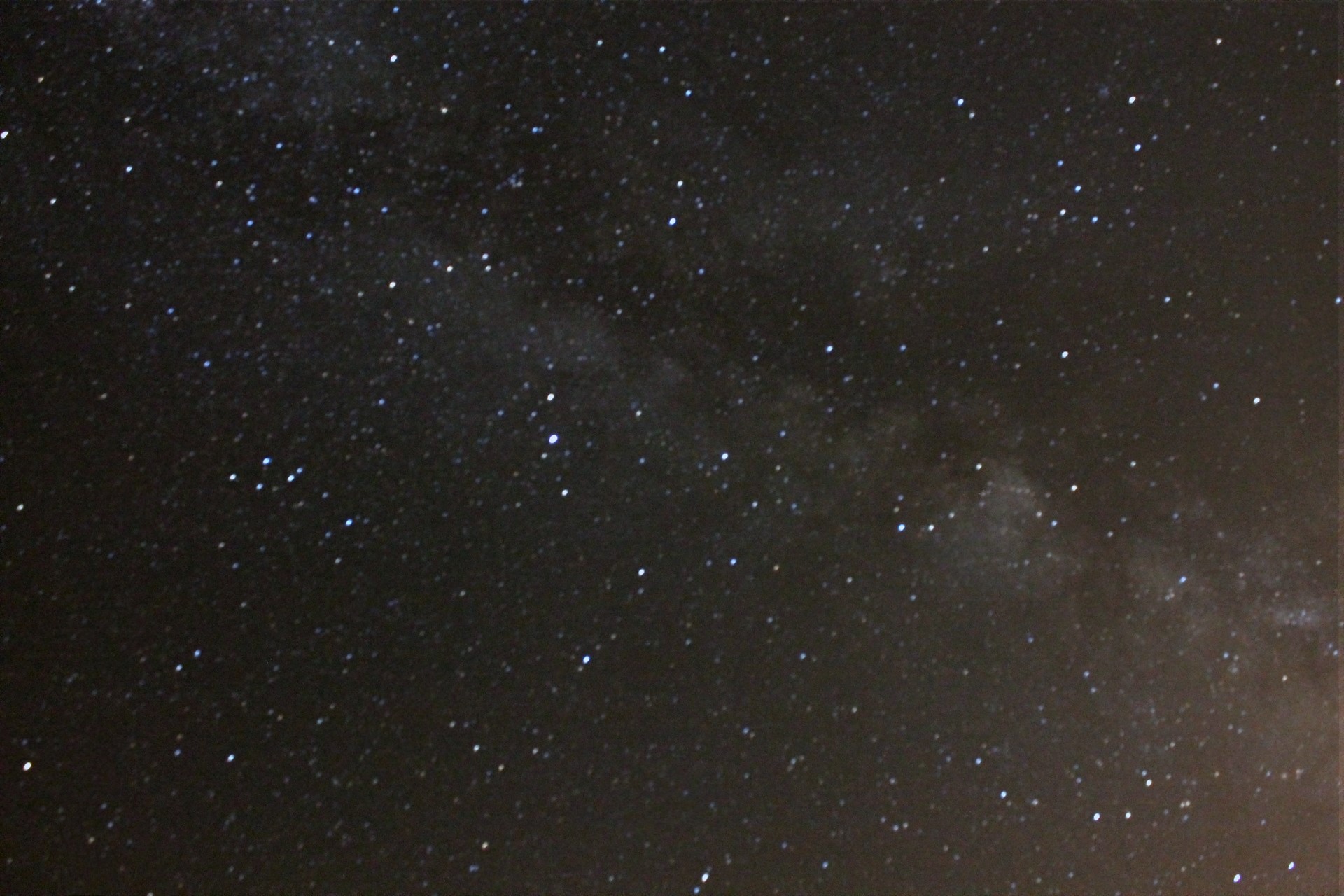
They were all at ISO 6400, with the lens set to 18mm, f5.6. About half were at 20 seconds exposure and the other half at 30 seconds exposure.
The bottom right hand corner is lit up mostly due to a security lamp on a power pole about 400 yards away, heh.

edit on 2/14/2017 by eriktheawful because: (no reason given)
Erik,
Do you have a solar filter for your lens?
If not, there seems to be a wide price range. Any thoughts on picking one prior to the big show later this year?
S+F, thanks for the cool pix! And sharing how difficult this hobby can be.
Do you have a solar filter for your lens?
If not, there seems to be a wide price range. Any thoughts on picking one prior to the big show later this year?
S+F, thanks for the cool pix! And sharing how difficult this hobby can be.
a reply to: TEOTWAWKIAIFF
I had one for a 4.5 inch newtonian telescope I owned, back in the late 1990s.
My oldest son stepped on it, heheheh: CRACK.
I'm planning on getting one for my newer 5 inch telescope I own.
I had one for a 4.5 inch newtonian telescope I owned, back in the late 1990s.
My oldest son stepped on it, heheheh: CRACK.
I'm planning on getting one for my newer 5 inch telescope I own.
a reply to: eriktheawful
Ouch! Those things can be expensive!
I did a bit of late research on acquiring either a telescope or even filter back during the transit of Venus. Ended up doing a projection onto paper through a monocular that I borrowed! Worked OK! And did not have shell out money that was lean at the time!
Best wishes on your hobby! Please keep ATS updated with any cool ones you capture!
Ouch! Those things can be expensive!
I did a bit of late research on acquiring either a telescope or even filter back during the transit of Venus. Ended up doing a projection onto paper through a monocular that I borrowed! Worked OK! And did not have shell out money that was lean at the time!
Best wishes on your hobby! Please keep ATS updated with any cool ones you capture!
a reply to: TEOTWAWKIAIFF
There are a few "poor man" way to view solar eclipses:
Pin Hole Box: You take a cardboard box, make a small hole in it, and then use a sheet of paper that you project the sun on:
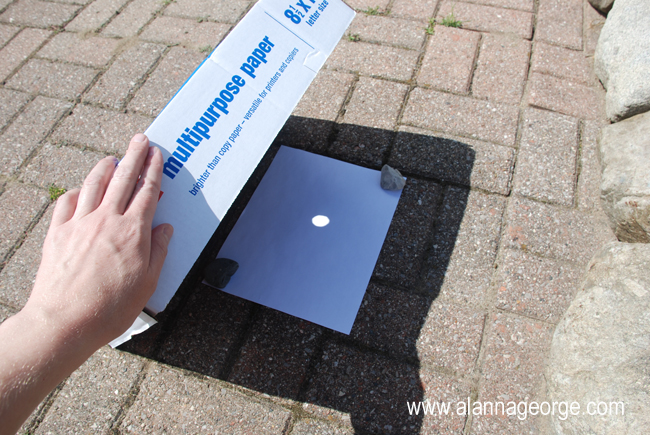
Smoked Glass: You take a clear pane of glass, and light off a candle. Move the glass back and forth in the top of the candle flame, and it will deposit soot on to the glass in a thick coat. You can see the sun through this.
Welders Mask: Find a old arc welders mask. It will work fine for looking at the sun.
Plate Viewer: Make an attachment for the eye piece holder of your telescope that holds a white painted plate several inches (to a foot or so) from the eye piece. Take the eye piece out, point the telescope at the sun, and it's image will be displayed on the plate. My 7th grade science teacher had this back in...ooooh....1978? It was cool. We got to see sun spots that way.
There are a few "poor man" way to view solar eclipses:
Pin Hole Box: You take a cardboard box, make a small hole in it, and then use a sheet of paper that you project the sun on:

Smoked Glass: You take a clear pane of glass, and light off a candle. Move the glass back and forth in the top of the candle flame, and it will deposit soot on to the glass in a thick coat. You can see the sun through this.
Welders Mask: Find a old arc welders mask. It will work fine for looking at the sun.
Plate Viewer: Make an attachment for the eye piece holder of your telescope that holds a white painted plate several inches (to a foot or so) from the eye piece. Take the eye piece out, point the telescope at the sun, and it's image will be displayed on the plate. My 7th grade science teacher had this back in...ooooh....1978? It was cool. We got to see sun spots that way.
Ignore reply I'm tryin to post pictures on the forum but for whatever reason I'm having difficulties .. plus it's gone 2am I need sleep I'll be back
tomorrow with a proper reply and with my pictures showing on the forum
Apologies for a wasted reply
Apologies for a wasted reply
edit on 14-2-2017 by ThePeaceMaker because: I gave up
a reply to: eriktheawful
Awesome!
It's always such a pleasure to see photographs from the stars, nebulae, galaxies. Never gets boring to me.
Always been fascinated with everything from above and beyond
Astrophotography has also been a dream for me, never had time or money to really get into, until lately.
As a matter of fact, I just received a 14mm 2.8 today which I will use for wide field astro and daytime landscaping.
Couple weeks ago the tracking mount also arrived.
Only been out for 2 nights as the weather isn't cooperating. It happens to be that those 2 nights were the coldest we had this season.
Hopefully we get some descent weather soon as I will be going on a trip to one of the darkest regions(in terms of light pollution).
Finally the young boy can come to life
I will share a picture from the first night out testing the tracking mount. Of course it had to be Orion's Nebulae and Andromeda
Orion M42
 Andromeda M31 Mono
Andromeda M31 Mono
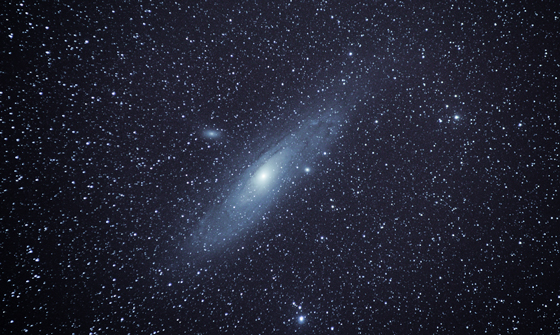 Andromeda M31 Color
Andromeda M31 Color

Milky way and meteor during the perseids meteor shower 2016

Only used dark frames so it's pretty noticeable the background gradient.
There is a lot to learn inthis field and it takes time and patience.
Also been thinking to get a cheap 500mm, maybe one of those mirror lenses. Any experience with those?
Awesome!
It's always such a pleasure to see photographs from the stars, nebulae, galaxies. Never gets boring to me.
Always been fascinated with everything from above and beyond
Astrophotography has also been a dream for me, never had time or money to really get into, until lately.
As a matter of fact, I just received a 14mm 2.8 today which I will use for wide field astro and daytime landscaping.
Couple weeks ago the tracking mount also arrived.
Only been out for 2 nights as the weather isn't cooperating. It happens to be that those 2 nights were the coldest we had this season.
Hopefully we get some descent weather soon as I will be going on a trip to one of the darkest regions(in terms of light pollution).
Finally the young boy can come to life
I will share a picture from the first night out testing the tracking mount. Of course it had to be Orion's Nebulae and Andromeda
Orion M42



Milky way and meteor during the perseids meteor shower 2016

Only used dark frames so it's pretty noticeable the background gradient.
There is a lot to learn inthis field and it takes time and patience.
Also been thinking to get a cheap 500mm, maybe one of those mirror lenses. Any experience with those?
a reply to: ThePeaceMaker
It's okay. Been here on ATS like that, falling asleep at the keyboard so I understand.
Let us know if you still need help getting your pics uploaded. We have threads on how to do that and just about an one here will help.
It's okay. Been here on ATS like that, falling asleep at the keyboard so I understand.
Let us know if you still need help getting your pics uploaded. We have threads on how to do that and just about an one here will help.
a reply to: intergalactic fire
Awesome PICS!!!
Thank you for sharing them!
I've not had any experience with a 500mm lens itself, just through the telescope versions.
However, I'm about to get that experience with the 500mm lens I purchased today and am waiting for it to be shipped here.
Make sure you share your pics in our sticky'ed Astrophotography thread too. Here's a link:
www.abovetopsecret.com...
Awesome PICS!!!
Thank you for sharing them!
I've not had any experience with a 500mm lens itself, just through the telescope versions.
However, I'm about to get that experience with the 500mm lens I purchased today and am waiting for it to be shipped here.
Make sure you share your pics in our sticky'ed Astrophotography thread too. Here's a link:
www.abovetopsecret.com...
originally posted by: eriktheawful
a reply to: ThePeaceMaker
It's okay. Been here on ATS like that, falling asleep at the keyboard so I understand.
Let us know if you still need help getting your pics uploaded. We have threads on how to do that and just about an one here will help.
I should be asleep I know ... the issue I have/had with them they were not uploading to tinypic.com on my phone (I mainly use my phone for the internet) so today/tomorrow I'll jump on my dads laptop and hope to upload them that way. Eventually I will get there and maybe some people can give me some tips after looking at my photos
Like I said I'm a beginner so I'm still reading up on a lot of things but sometimes it's better to get the help from people that already know
Either way greats pics on this thread! I'll message back on here within the next 24 hours
a reply to: eriktheawful
Do yourself a favour and get to the Australian outback , no pollution of ant kind and a very high percentage of cloudless nights . A few other places in the link below . If you like fishing Exmouth has some of the best fishing in the world .
gadling.com...
Do yourself a favour and get to the Australian outback , no pollution of ant kind and a very high percentage of cloudless nights . A few other places in the link below . If you like fishing Exmouth has some of the best fishing in the world .
gadling.com...
f-Stop
"f" stops, not to be confused with this kind of "stop"
For those of you who don't know, or are new to this, f-stops is basically our way of telling the camera how much light to let in.
Now a days, with modern cameras (especially if you're using like a smart phone camera), everything is automatic. You don't need to worry about what your f-stop is, and most modern day DSLR cameras have automatic settings for most of the different modes where the f-stop will be done automatically.
Basically it's the opening and closing of the iris in the camera lens. The lower the "f" number, the wider the iris opening is, or "faster" the light coming into the camera will be. As such, the higher the "f" number, the slower the light coming in is because the iris is made smaller, like the image shown below:
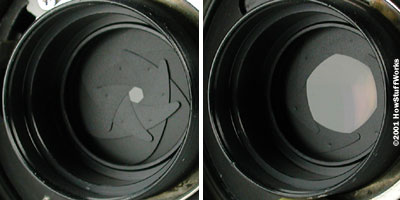
As I mentioned in my OP of this thread, back in the day when I was still using film, using a SLR camera meant picking up that 35mm film. Most common film "speed" at the time was ISO 400 and ISO 800. They also made higher numbers, but were less common in the stores and more expensive to get.
The film speed is how sensitive the film is to light. The higher the number, the more sensitive it is, or "faster" it is. Problem was that the really higher numbers like ISO 1000, ISO 1600, the grainier the print would look.
With today's modern digital cameras, you can still set the "speed" of the "film". You're basically setting how sensitive the CCD chip is going to be to the light you expose it to (it's much more complex than that, but is a good enough analogy to understand what is going on). Ironically, the higher the ISO setting on a digital camera, the more noise you'll see in your camera shots during longer exposures. This is also something that is automatic on most smart phone cameras and in the automatic settings on DSLR cameras.
So below are some examples of me playing around with both the ISO setting and f-Stop settings tonight. All frames were 15 second exposures with the lens set to 18mm
ISO 1600, f 5.6
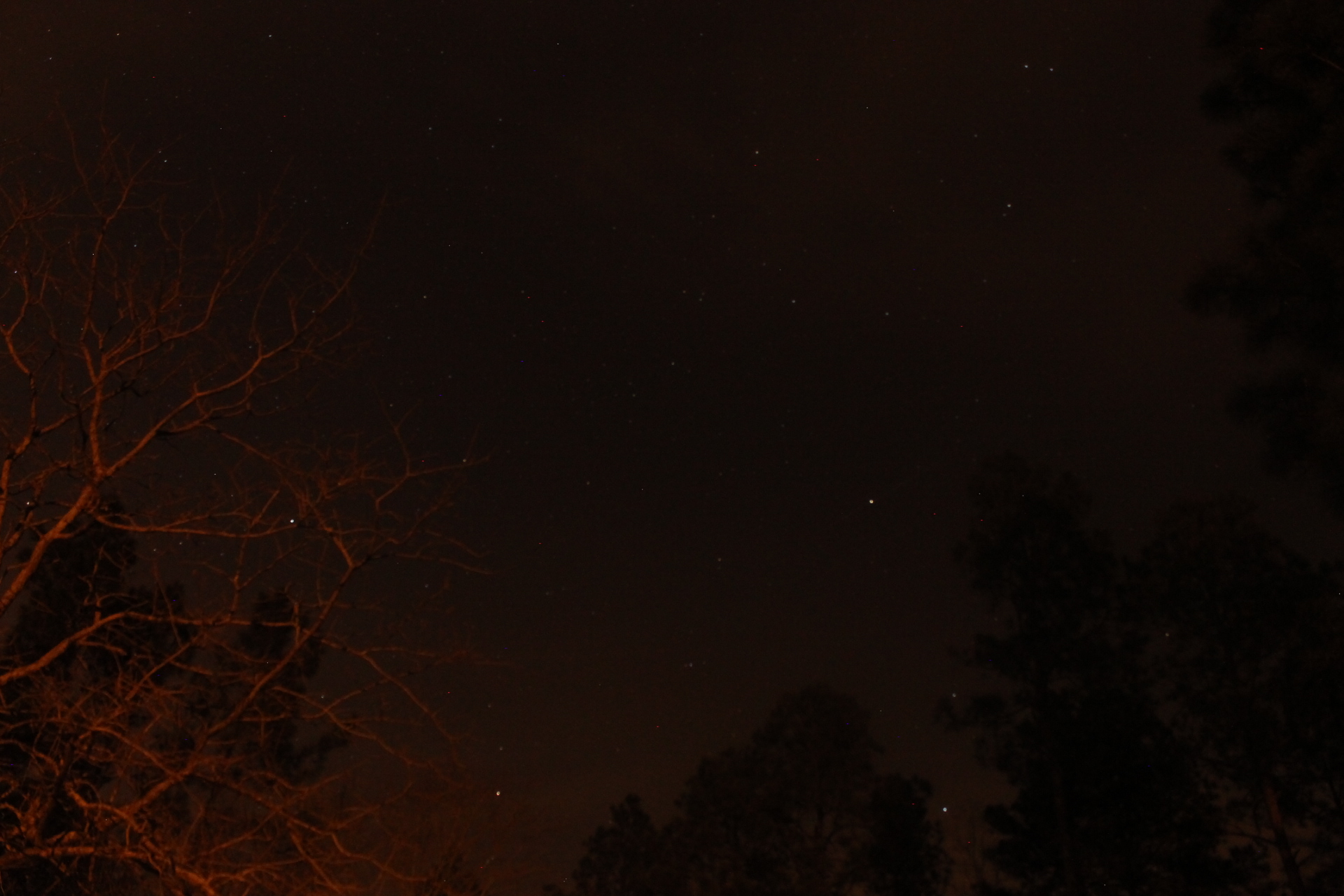
ISO 1600, f 3.5
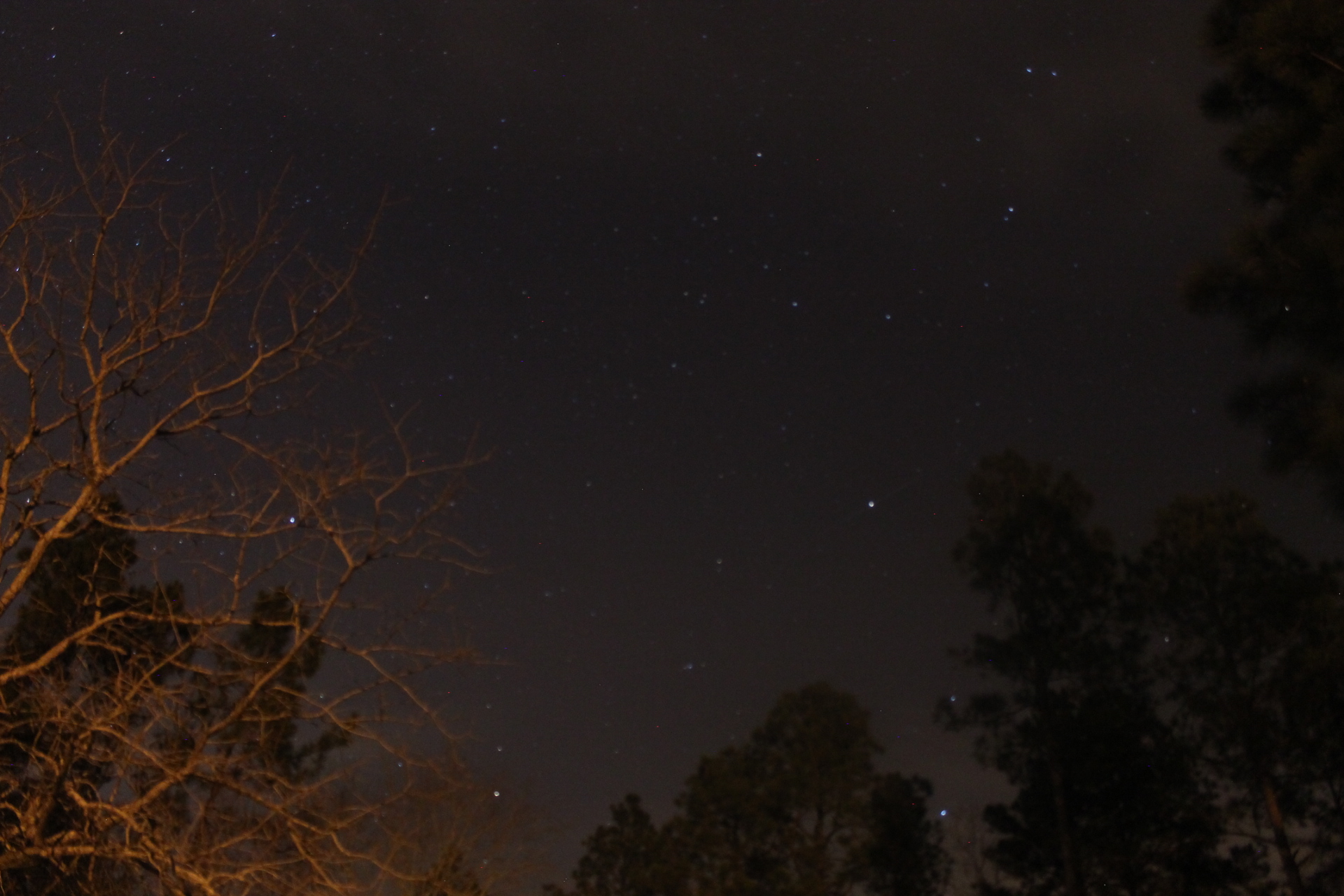
ISO 3200, f 6.3
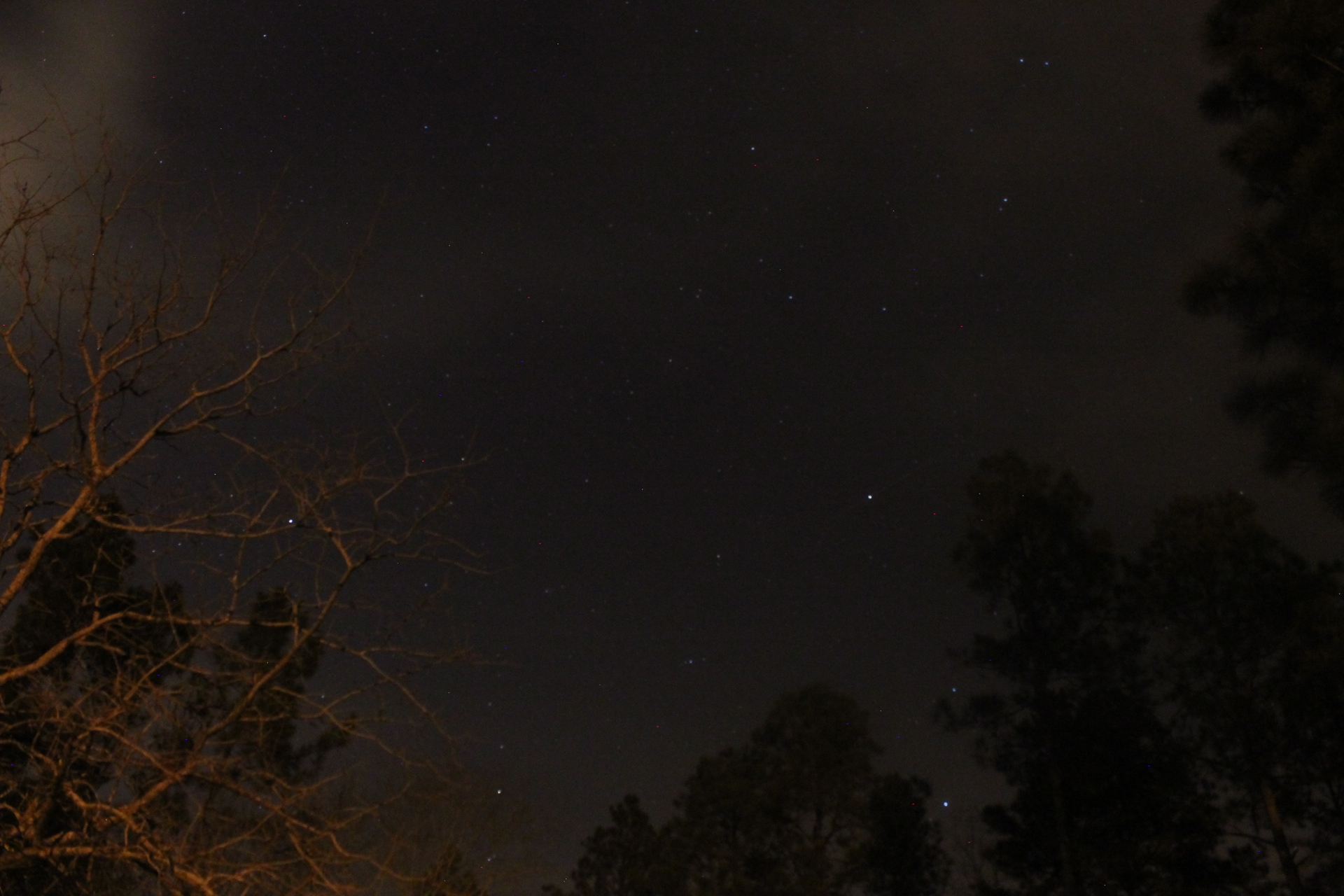
ISO 3200, f 3.5
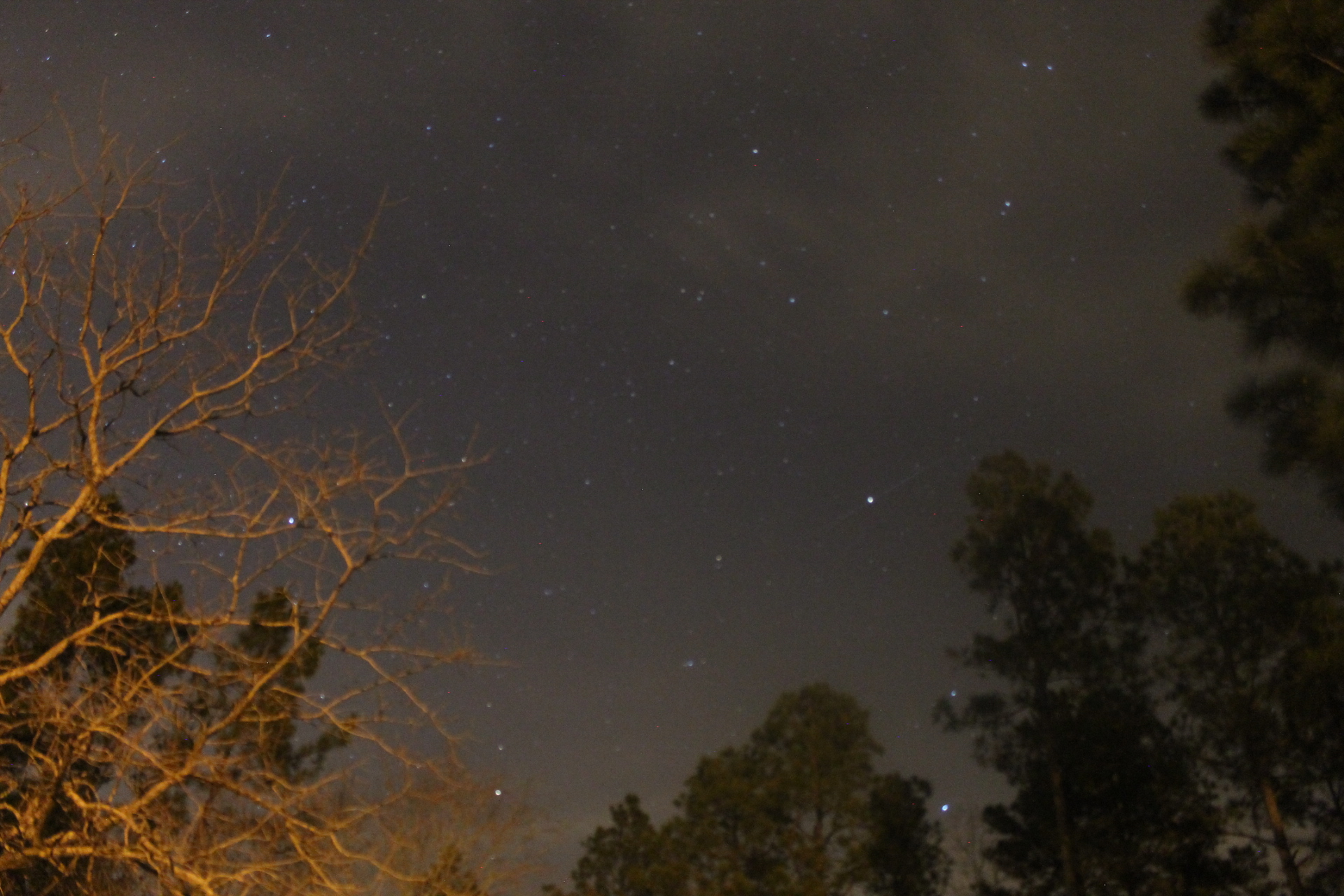
ISO 6400, f 6.3
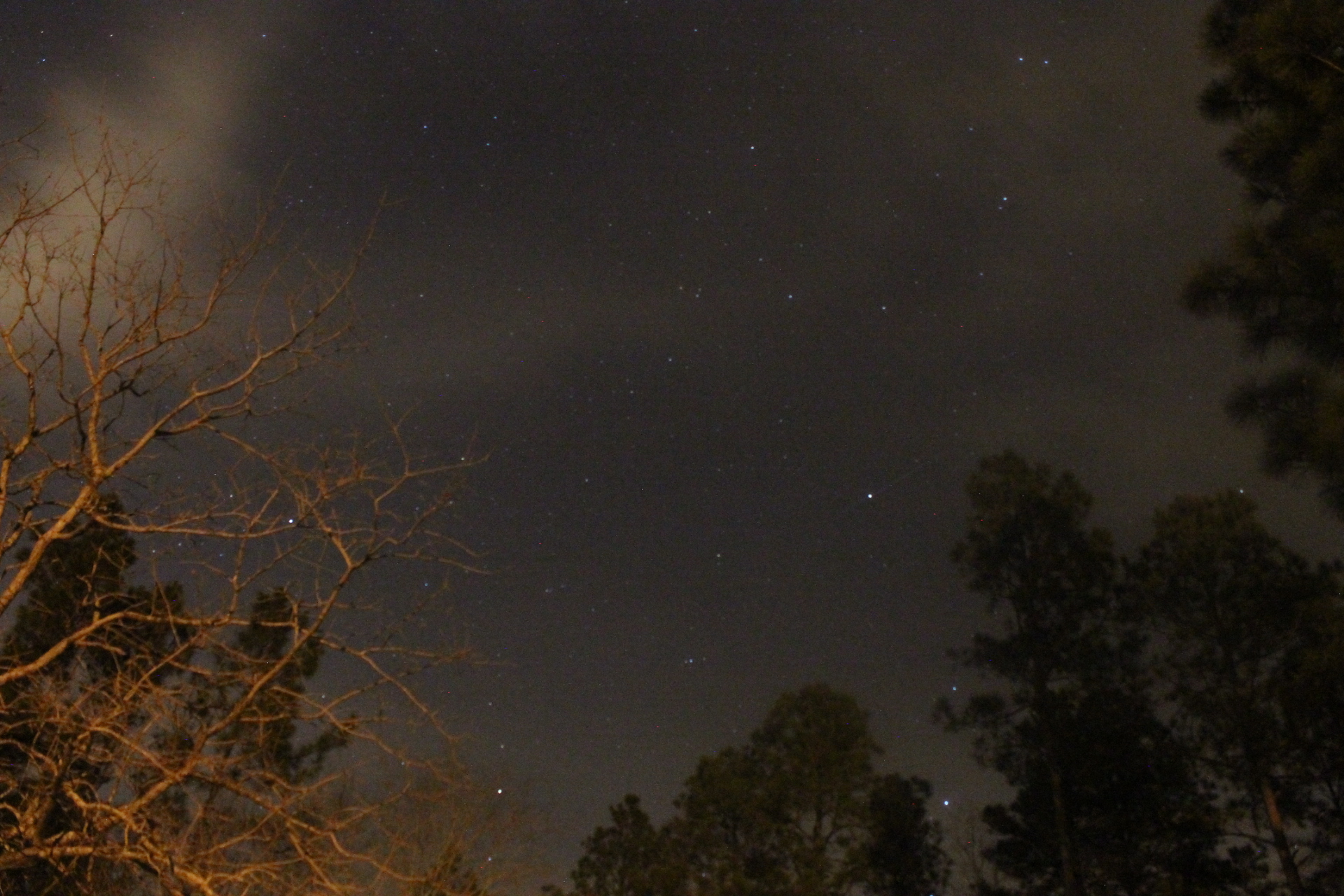
ISO 6400, f 3.5
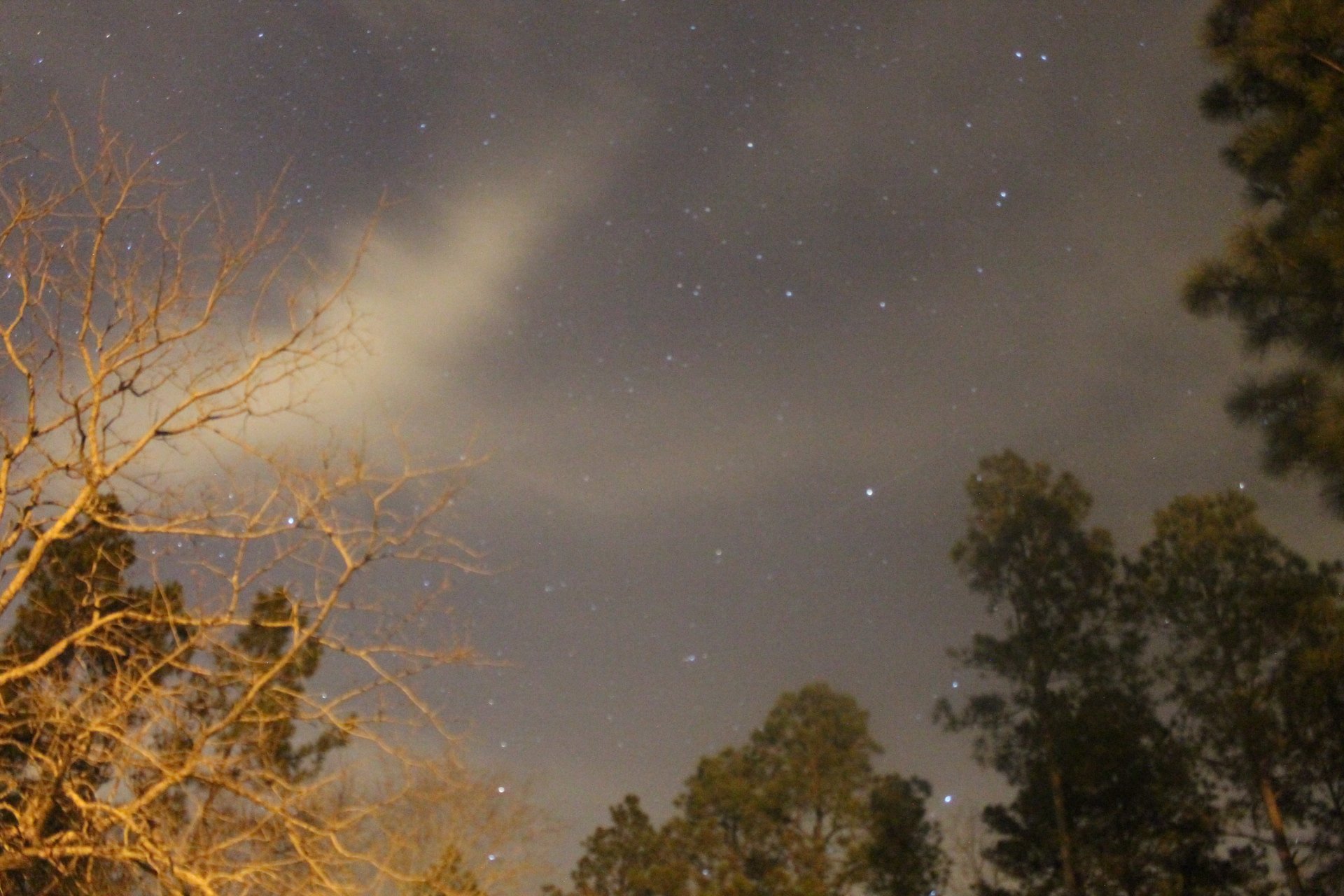
Notice by the time I get to ISO 6400 with the iris wide open at f 3.5, it looks damn near like day light outside, but there is a very large amount of noise in the image.
When taking star shots with just the camera a lens, what ISO and f-Stop you use will depend a lot on what you want to do. But again, in this day and age of digital cameras, the DSLR's, you can try many different settings and see right away what you are getting.
In the old days, with film, by the time you get your pictures developed, you may have forgotten what you have everything set to. I certainly did on many occasions.
edit on 2/14/2017 by eriktheawful because: (no reason given)
new topics
-
Former Labour minister Frank Field dies aged 81
People: 20 minutes ago -
SETI chief says US has no evidence for alien technology. 'And we never have'
Aliens and UFOs: 2 hours ago -
This is our Story
General Entertainment: 4 hours ago -
President BIDEN Vows to Make Americans Pay More Federal Taxes in 2025 - Political Suicide.
2024 Elections: 6 hours ago -
Ode to Artemis
General Chit Chat: 7 hours ago -
Ditching physical money
History: 11 hours ago -
One Flame Throwing Robot Dog for Christmas Please!
Weaponry: 11 hours ago -
Don't take advantage of people just because it seems easy it will backfire
Rant: 11 hours ago
top topics
-
University student disciplined after saying veganism is wrong and gender fluidity is stupid
Education and Media: 15 hours ago, 14 flags -
President BIDEN Vows to Make Americans Pay More Federal Taxes in 2025 - Political Suicide.
2024 Elections: 6 hours ago, 10 flags -
One Flame Throwing Robot Dog for Christmas Please!
Weaponry: 11 hours ago, 6 flags -
Should Biden Replace Harris With AOC On the 2024 Democrat Ticket?
2024 Elections: 13 hours ago, 6 flags -
Don't take advantage of people just because it seems easy it will backfire
Rant: 11 hours ago, 4 flags -
Ditching physical money
History: 11 hours ago, 4 flags -
SETI chief says US has no evidence for alien technology. 'And we never have'
Aliens and UFOs: 2 hours ago, 3 flags -
God lived as a Devil Dog.
Short Stories: 16 hours ago, 3 flags -
Ode to Artemis
General Chit Chat: 7 hours ago, 2 flags -
VirginOfGrand says hello
Introductions: 12 hours ago, 2 flags
active topics
-
Former Labour minister Frank Field dies aged 81
People • 2 • : Freeborn -
Terrifying Encounters With The Black Eyed Kids
Paranormal Studies • 72 • : Consvoli -
The Superstition of Full Moons Filling Hospitals Turns Out To Be True!
Medical Issues & Conspiracies • 24 • : angelchemuel -
SETI chief says US has no evidence for alien technology. 'And we never have'
Aliens and UFOs • 13 • : andy06shake -
"We're All Hamas" Heard at Columbia University Protests
Social Issues and Civil Unrest • 266 • : KrustyKrab -
Russia Ukraine Update Thread - part 3
World War Three • 5720 • : Freeborn -
University student disciplined after saying veganism is wrong and gender fluidity is stupid
Education and Media • 32 • : BedevereTheWise -
So this is what Hamas considers 'freedom fighting' ...
War On Terrorism • 227 • : HopeForTheFuture -
Remember These Attacks When President Trump 2.0 Retribution-Justice Commences.
2024 Elections • 51 • : Justoneman -
British TV Presenter Refuses To Use Guest's Preferred Pronouns
Education and Media • 131 • : FlyersFan
